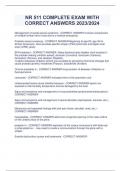Beleggingsanalyse en
Portefeuillebeheer
Deel 2
ACADEMIEJAAR 2017-2018
PROF K. INGHELBRECHT
,Inhoudsopgave
4 Efficient Diversification ................................................................................................................... 4
4.1 Diversificatie en portefeuillerisico ................................................................................................... 4
4.1.1 Twee risicobronnen ................................................................................................................. 4
4.2 Optimal portfolio met 2 risicodragende activa ............................................................................... 5
4.2.1 Belang van de correlatie! ......................................................................................................... 6
4.2.2 Investment Opportunity Set .................................................................................................... 9
4.2.3 Optimal risky portfolio ............................................................................................................. 9
4.3 Optimal portfolio met 2 risicodragende activa en een risicovrij actief .......................................... 10
4.3.1 Optimal complete portfolio ................................................................................................... 11
4.3.2 Stappen om de optimal complete portfolio te bepalen ........................................................ 11
4.4 Diversificatie met n aantal risicodragende assets ......................................................................... 12
4.4.1 De efficient frontier voor risicodragende activa .................................................................... 13
4.4.2 Mean-variance criterion ........................................................................................................ 13
4.4.3 Efficient Frontier of Risky Assets with Optimal CAL............................................................... 14
4.4.4 Seperation property .............................................................................................................. 14
4.4.5 Portfolio construction: in de praktijk ..................................................................................... 15
4.4.6 Probleem ............................................................................................................................... 18
4.4.7 Index models ......................................................................................................................... 19
4.4.8 SIM en diversificatie .............................................................................................................. 21
4.5 Asset allocation vs security selection ............................................................................................ 23
4.5.1 Asset allocation ..................................................................................................................... 24
5 CAPM & Multifactor model ........................................................................................................... 26
5.1 Capital Asset Pricing Model ........................................................................................................... 26
5.1.1 Market Portfolio .................................................................................................................... 27
5.1.2 Capital Market Line and Separation Property ....................................................................... 28
5.1.3 Security Market Line .............................................................................................................. 31
5.1.4 CAPM and Single-Index Model .............................................................................................. 34
5.1.5 Toepassingen van het CAPM ................................................................................................. 34
5.1.6 Example (Google) .................................................................................................................. 35
5.1.7 CAPM and the Real World ..................................................................................................... 38
5.2 Multifactor Model ......................................................................................................................... 40
5.2.1 Identifying the Factors ........................................................................................................... 40
5.2.2 Fama and French 3 Factor Model .......................................................................................... 41
5.2.3 Example ................................................................................................................................. 41
5.2.4 Factor model met macro-economische variabelen ............................................................... 43
5.2.5 Samenvatting ......................................................................................................................... 43
6 Market Efficiency & Behavioural Finance ...................................................................................... 44
6.1 Market Efficiency........................................................................................................................... 44
6.1.1 Active versus passive management ....................................................................................... 44
6.1.2 Why does it matter? .............................................................................................................. 44
6.1.3 Why Should Capital Markets Be Efficient? ............................................................................ 46
6.1.4 Alternative Efficient Market Hypotheses .............................................................................. 46
6.1.5 Implications of Market Efficiency .......................................................................................... 47
6.1.6 Role of Portfolio Management in Efficient Markets .............................................................. 50
6.1.7 Are Markets Efficient? ........................................................................................................... 50
6.2 Behavioural Finance ...................................................................................................................... 53
7 Equity Valuation ............................................................................................................................ 55
7.1 Inleiding ......................................................................................................................................... 55
7.2 Verwachte return vs vereiste return .............................................................................................. 56
7.3 Intrinsieke waarde vs marktprijs ................................................................................................... 57
7.3.1 De intrinsieke waarde: praktisch ........................................................................................... 58
2
, 7.4 Dividend Discount Models ............................................................................................................. 58
7.4.1 Constant Growth DDM .......................................................................................................... 59
7.4.2 Stock Prices and Investment Opportunities .......................................................................... 60
7.4.3 Other Discounted Cash Flow Approaches ............................................................................. 61
7.4.4 Opmerkingen ......................................................................................................................... 61
7.5 Price-Earnings Ratio ...................................................................................................................... 61
7.5.1 Understanding Price-Earnings Ratio ...................................................................................... 62
7.5.2 Price/Earnings Ratio and Growth Opportunities ................................................................... 62
7.5.3 Price-Earnings Ratios for Different Industries ....................................................................... 64
7.5.4 P/E Ratios and Stock Risk ....................................................................................................... 64
7.5.5 Pitfalls in P/E Analysis ............................................................................................................ 64
7.5.6 P/E en verwachte returns ...................................................................................................... 65
7.6 Andere multiples ........................................................................................................................... 65
7.7 Welke benadering is nu het beste? ............................................................................................... 65
7.8 The Aggregate Stock Market......................................................................................................... 66
8 Bond valuation and bond portfolio management .......................................................................... 67
8.1 Types of Bonds .............................................................................................................................. 67
8.1.1 Overheidsobligaties ............................................................................................................... 67
8.1.2 Bedrijfsobligaties ................................................................................................................... 68
8.1.3 Inflation-indexed bonds......................................................................................................... 68
8.2 Bond Pricing .................................................................................................................................. 68
8.2.1 Market Interest Rate r ........................................................................................................... 69
8.2.2 Inverse Relation between Bond Prices and Yield .................................................................. 69
8.2.3 Why do bond prices change? ................................................................................................ 70
8.2.4 Default Risk or Credit Risk ..................................................................................................... 70
8.2.5 Zero-Coupon Bonds ............................................................................................................... 72
8.3 Bond Yields .................................................................................................................................... 72
8.3.1 Yield to Maturity .................................................................................................................... 72
8.3.2 Yield Curve ............................................................................................................................. 73
8.3.3 Theories of the Term Structure ............................................................................................. 73
8.4 Investing in Bonds: Holding-Period Returns .................................................................................. 75
8.5 Managing Bond Portfolios ............................................................................................................ 76
8.5.1 Interest Rate Risk and Duration ............................................................................................. 76
8.5.2 Passive Bond Management (Immunization) .......................................................................... 78
8.5.3 Convexity ............................................................................................................................... 80
8.5.4 Active Bond Management ..................................................................................................... 81
9 Portfolio performance evaluation ................................................................................................. 82
9.1 Investment Performance Evaluation ............................................................................................. 82
9.2 Simple Method: Comparison Universe .......................................................................................... 82
9.3 How to account for risk? ............................................................................................................... 83
9.4 Different measures: ....................................................................................................................... 83
9.4.1 Sharpe Ratio .......................................................................................................................... 83
9.4.2 Treynor Measure ................................................................................................................... 84
9.4.3 Jensen’s Alpha ....................................................................................................................... 85
9.4.4 M2 Measure .......................................................................................................................... 85
9.4.5 Information Ratio .................................................................................................................. 86
9.5 Portfolio Construction versus Evaluation ...................................................................................... 86
9.6 Which measure is appropriate? .................................................................................................... 86
3
,4 Efficient Diversification
Efficient: verwachte returns laten stijgen
Diversificatie: het verwachte risico laten dalen
Focus op portfolio management: combineren van verschillende assets.
4.1 Diversificatie en portefeuillerisico
4.1.1 Twee risicobronnen
Diversificatie = Verschillende activa combineren binnen je portfolio. Zo reduceer je het risico van je
portfolio. Waarom? Je portefeuille bezit 2 bronnen van risico:
ð Het specifiek risico van een individueel asset
Dit deel kan sterk verminderd worden door diversificatie.
o Dus een diversifieerbaar risico
o Groei van de verkopen, R&D, relatieve prestaties
o Wordt beïnvloed door de beslissingen binnen het bedrijf zelf
o Het niet-systematisch risico of idiosyncratisch (bedrijfsspecifiek) risico
ð Het algemeen risicodeel
o Alle aandelen worden aangetast door systematische of marktrisico.
o Dit is dus het niet-diversifieerbaar risico
o Business cycle, inflatievoet, intrestvoeten, wisselkoersen, …
Voorbeeld met Dell en Exxon Mobil
Stel er is een economische recessie waarbij de winst van beide bedrijven worden aangetast.
Maar door individuele beslissingen van de bedrijven zal de prijs van Dell toch nog stijgen en van Exxon
Mobil dalen. Je portefeuille zal dus stabieler zijn.
4
,X-as = het aantal aandelen in je portfolio.
Y-as = het risico van de portfolio.
Er blijft wel een ondergrens aan het diversifieerbaar risico => dit is het marktrisico.
Hoeveel aandelen om efficiënt te gaan diversifiëren?
20 aandelen in je portefeuille zijn genoeg om een voldoende risicodaling te realiseren.
Waarom niet meer?
ð Hoe meer aandelen, hoe meer transactiekosten je zal moeten betalen wat dan uiteindelijk zal
wegen op je return
4.2 Optimal portfolio met 2 risicodragende activa
We gaan nu uit van een portefeuille met 2 risicodragende activa:
- Aandelen (S)
- Obligaties (B)
We zoeken de optimale weging voor aandelen en obligaties binnen onze risky portfolio.
3 belangrijke formules:
1. Return van de portefeuille Herhaling covariantie:
𝑟" = 𝑤% 𝑟% + 𝑤' 𝑟' In welke mate hangen 2 kansvariabelen
met elkaar samen? Vergelijkbaar met de
2. Verwachte return van de portefeuille correlatiecoëfficiënt alleen hangt de cov af
𝐸 𝑟" = 𝑤% 𝐸 𝑟% + 𝑤' 𝐸 𝑟' van de schaal (1 betekent dus niet per se
een sterk verband)
3. Variantie van de portefeuille (risico)
𝜎"* = 𝑤% 𝜎% * + 𝑤' 𝜎' * + 2𝑤% 𝑤' 𝑐𝑜𝑣 𝑟% , 𝑟'
*w staat voor de toegekende gewichten voor elk asset.
5
, 4.2.1 Belang van de correlatie!
Correlatieformule:
𝑐𝑜𝑣 𝑟% , 𝑟' = 𝑐𝑜𝑟𝑟 𝑟% , 𝑟' 𝜎% 𝜎'
= 𝝆𝒔𝒃 𝜎% 𝜎'
Correlatie = 𝝆𝒔𝒃 : 2 cruciale grenswaarden
o -1 : de assets bewegen in tegengestelde richting (stijgt A, dan daalt B)
o 1 : de assets bewegen steeds in dezelfde richting (beide stijgen, beide dalen)
Correlatie = -1
ð We kunnen de formule inkorten en er is de mogelijkheid om het risico volledig te elimineren!
Voorbeeld
ð Stel risico aandelen = 12%; gewicht = 25%
ð Risico obligaties = 4%; gewicht = 75%
ð Met een correlatie van -1 wordt het risico gelijk aan:
𝜎" = 0,25 ∗ 0,12 − 0,75 ∗ 0,04 = 0
Opmerking 1:
Als de markt efficiënt werkt dan zou de return op de portfolio zonder risico gelijk moeten zijn aan de
risicovrije rentevoet.
Opmerking 2:
Je zal in de praktijk nooit een correlatie van -1 bekomen. Het risico kan dus nooit volledig geëlimineerd
worden.
Correlatie = +1
Is de correlatie gelijk aan 1 dan is er geen diversificatie mogelijk.
Opmerking: uitzondering als je toelaat dat de weging van obligaties bijvoorbeeld -0,5 is (negatief).
ð We hebben het dus over shortselling
6












